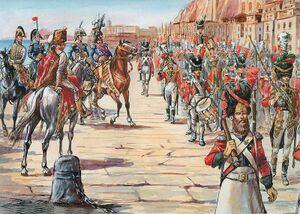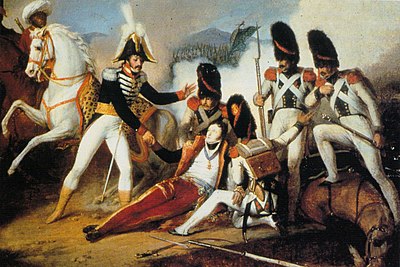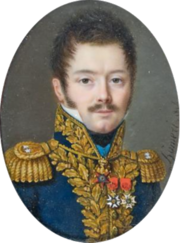Army of the Kingdom of Naples
Army of the Kingdom of Naples
The Esercito (army) was the most active component of the Kingdom's Armed Forces.
During the French Decade, the Neapolitan Army would grow to become one of Europe's most versatile bodies of men.
Overview |
|
The Army of the Kingdom of Naples was the most active component of the Kingdom’s Armed Forces. Organised along French lines, it was founded in February 1806 from volunteers and the wreckage of the army of the Bourbon Kingdom of Naples. As a modern force, it was compromised of various regiments of infantry, cavalry, artillery, and engineers, quite literally organised as replicas of their French counterparts within the Grande Armée. At its peak size in 1815, the Neapolitan army had a total (on-paper) strength of 94,463 men split into 35 regiments and numerous smaller units. The army consisted of four main “branches”: the Royal Guard, the troops of the Line, the technical troops, and the troops of the interior. It was almost completely shaped and modelled to mirror the French armed forces, save for the interior troops. Under the terms of the Treaty of Bayonne, Naples was obliged to supply the Grande Armée with 16,000 infantry, 2,500 light cavalry, and twenty pieces of field artillery; these goals were never met in full, although the Army itself far exceeded this number by 1810. In 1815, over 70% of the regular army was composed of infantry, three fifths of which were from the line regiments. The cavalry composed around 11%, the split between Guard and Line being relatively even; the remainder of the army was composed of the technical troops (artillery, engineers, and train). This meant that the overall ratio of infantry to cavalry within the army was 6:1, almost double that of the French Army at Waterloo. Neapolitan troops would serve for many years across various theatres, including in home territory against insurgents and British landings, and in foreign lands such as Spain, Russia, and Germany, albeit with a minor role. In Calabria, the Neapolitans played a crucial role in maintaining the Napoleonic Empire’s southern border in the face of continuous naval landings. Upon Murat’s change of allegiance, the Army fought with little distinction against their old allies in Northern Italy; Neapolitan honour would fortunately be redeemed a year later in the brave but ultimately disastrous Neapolitan War. |
| |
|
The Neapolitan troops excelled in rapid, irregular combat, as opposed to their frequent failures in formed masses. Unsurprisingly, the first four regiments to be raised were the 1st Light (16th February 1806) and the 1st Horse Chasseurs (18th February), followed by the 2nd Light (27th May) and 2nd Horse Chasseurs (4th June). These were ostensibly raised to support the Armée de Naples’s efforts in fighting the Bourbon guerillas in the Kingdom’s rugged southern provinces. On June 13th the first two line infantry regiments were raised, followed by a third, fourth and fifth in 1809. By 1811, there would be seven line regiments. By its final expansion, the Army had twelve Line Infantry Regiments, four Light Infantry regiments, and four regiments of Line Cavalry (Chevaulegers) armed with lances. The Royal Guard was founded on 30th September 1806 as a corps consisting of a regiment each of Grenadiers and of Voltigeurs, a regiment of Chevaulegers, a squadron of Gendarmerie d’élite, and a company each of foot and horse artillery (in addition to an artillery train company). These would be composed almost entirely of French troops (elite companies taken from each regiment), and when Joseph Bonaparte took most of the Guard to Spain, only a few men were left behind, most of them Neapolitan nationals. When Joachim Murat was given the throne of Naples, the task of rebuilding his guard would prove to be daunting: Napoleon had barred him from taking any more troops from the French units stationed in the Kingdom, and most of his elite Berg troops were also transferred out of his reach. The only experienced men at his disposal were the officers of his entourage and a small squadron of Berg Chevaulegers. Hence, the new Royal Guard under Murat found itself initially led by competent French officers, but generally filled with volunteers and picked recruits. Distinguished rankers from the regiments serving in Spain were also transferred into the Guard as NCOs. By 1809, a huge ceremony was held in Naples to honour the founding of the Corps of Velites. This elite force was initially formed from a regiment of Foot Velites (two battalions) and one of Mounted Velites (two squadrons) and would consist of men recruited exclusively from the nobility and landed gentry. The foot Velites would later be increased to two regiments, and in 1813 the Mounted Velites would be renamed Hussars.
| |
| |
|
The 2nd Line Infantry Regiment (In Italian: 2o Reggimento Fanteria di Linea) was one of the oldest line infantry units of the Kingdom of Naples, existing since the beginning of Joseph’s reign. It served in several theatres but suffered from high rates of desertion, and hence had to be reraised several times from convicts and brigands. It served with distinction in Spain and earned considerable praise from French generals for its effectivity against Spanish guerrillas. Following the 1815 Campaign and the fall of the Kingdom, it was disbanded in June 1815. It was given the title “Regina” or Queen’s Own in 1811 for its distinguished service in the War in Spain. The 2nd Line Infantry Regiment was created with the decree of 13th June 1806 alongside its sister regiment, the 1st Line. Its creation came as a result of Napoleon’s desire for Naples to provide troops for his armies; this would be officially decreed in 1808 in the Treaty of Bayonne. The regiment was hence organised under an old Major named Onofrio, with Giuseppe Rosaroll and Ignazio Ritucci as battalion chiefs and D’Ambrosio, Brocchetti, Verdinois and Filangieri as captains (among others). Suffering from a lack of recruits, the regiment however was soon reorganised under the direction of generals Francesco Pignatelli and Compère and merged on 17th September 1806 with the newly-formed 3rd Line under Colonel Louis de Gambs. This officer, who had previously served in the Bourbon Army, was in fact a spy sent by the exiled government in Sicily; his father, also a senior officer, had secured him a commission in the new Kingdom’s army through connections to the King. (Full Article...)
|
| |
|
French General who distinguished himself as Colonel of the 1st Line in Spain Guillaume Alexandre Thomas Pégot was a French officer who joined the Army of Naples in 1806 seeking promotion and glory after a relatively uneventful and undistinguished career in the French Army. He was made Major of the 1st Line Infantry Regiment under Joseph and therefore became one of the Kingdom's Army's first superior officers, contributing significantly to the creation of the core of the Neapolitan line infantry arm. He would be promoted to Colonel in 1808 and spend the next few years leading his regiment during the Spanish campaign with distinction, earning the praise of General Duhesme. He would achieve the rank of Maresciallo di Campo in 1813. |
Related Pages | ||||||
|




